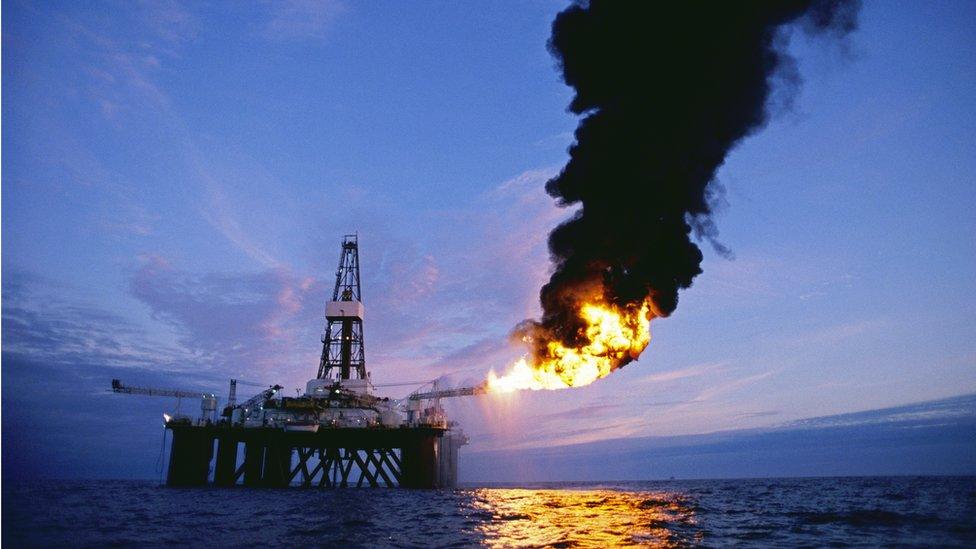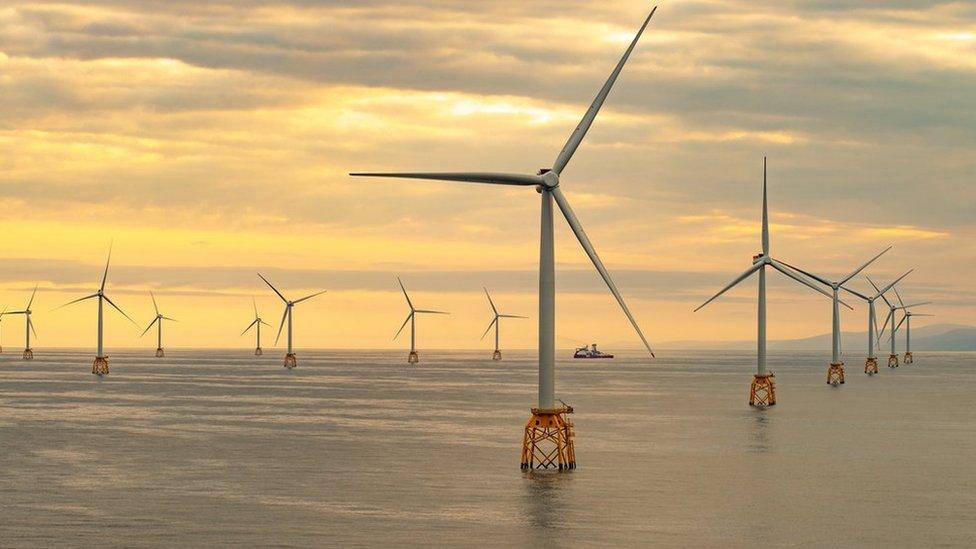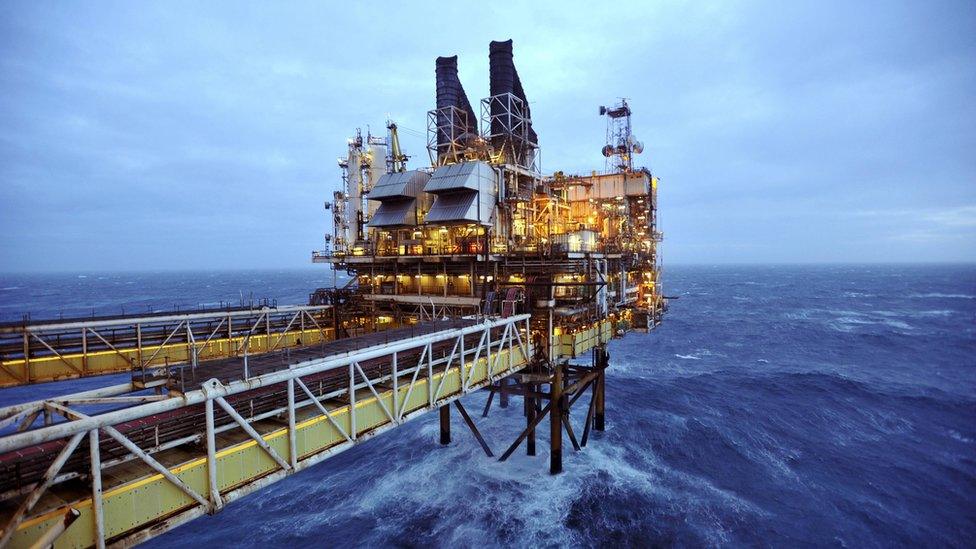Breaking up is hard to do, but lucrative
- Published

There is a £20bn ten-year opportunity to remove much of the oil and gas equipment from the North Sea, according to the industry's own assessment.
The boom times are already here, but as they gather pace, they will require careful co-ordination with the offshore wind sector, in competition for similar skills.
The spend is shifting into the central North Sea, east of the Scottish mainland, and will require several large decommissioning yards, and many skilled workers.
More than £20bn worth of work in only ten years, and more than half of it on the seabed and out of sight, is on offer to those wanting to become a link in the supply chain.
Removing a lot of kit from the North Sea is very expensive for the oil and gas industry, but can also be seen as a huge opportunity for a new sector, with global potential.
Over several decades, the North Sea Transition Authority - the UK government's agency - reckons the spend could be £40bn.
The latest assessment of the decommissioning of the North Sea's oil and gas facilities, published on Tuesday by industry body Offshore Energy UK (OEUK), suggests that the boom times are already under way.
This year is seeing a 37% increase in spend, to £2.2bn. More than £18bn of contracts are in the pipeline from 2024 to 2032.
That already represents one pound in every eight being spent in the UK oil and gas sector. That could rise to quarter of all spend by 2032, and as drilling and production continue their decline, more than half from 2040.

Beatrice is an offshore wind farm off Scotland's Caithness coast
But there is competition for specialist offshore vessels and skills in handling cranes, from the vast project to put many hundreds more wind turbines into UK waters.
While decommissioning costs have been in decline, if the sequencing and capacity is not right, the price could soar and harm both industries.
The vast business opportunity from decommissioning has been repeatedly delayed, as companies sweated those assets for the last of the reserves, and put off the day they had to send in the wrecking crew.
Some facilities have been maintained to avoid stranding untapped reserves that need old pipes and production platforms.
Pipelines, in particular, are being kept in place, to make sure they are not needed for carbon storage in old oil and gas wells, or for transporting hydrogen.
That will change and, as pipelines are loaded back on to vast cable barges or cut up on the seabed, there will be a need to remove around 37,000 concrete 'mattresses', which have held them in place.
More than half the expenditure is in thousands of wells which have to be capped, sealed and abandoned, using remotely-operated vehicles (ROVs).
These are used to oversee the pouring of concrete into wells, to prevent greenhouse gases being released into the atmosphere. There is a further, longer-term business opportunity in monitoring them.

So far, much of the work has been in the southern North Sea, where the first gas fields began production in the 1970s.
As the industry matures and reserves are exhausted in oil fields further north, the emphasis will shift to the central and northern North Sea, to the east of Orkney and Shetland.
By 2031, it is forecast that two-thirds of the industry spend will be in the central North Sea, to the east of the Scottish mainland.
The West of Shetland area is the newest to be developed and is furthest from decommissioning.
Until now, much of the onshore work has been carried out on Teesside, with its long-standing expertise in shipbreaking and handling chemicals.
But there will be a lot more work for many more decomm yards, with several readied for the pipeline on the east coast of Scotland and Shetland, as well as the re-opened yard at Loch Kishorn in Wester Ross.
Around 60% of the topsides and jackets (the production platforms and the seabed structures that support them) will be removed between 2026 and 2032.

The OEUK assessment of the industry's prospects brings together the industry's current activity and best guess of what is likely to come next. It is to inform the trade body's decommissioning conference in St Andrews today.
It says this year is seeing 210 wells being capped and decommissioned, eight topsides being removed and 10 jackets, for onshore repurposing and recycling.
Some 8,200 tonnes of subsea infrastructure is being removed and, although only 16km of pipeline is being removed, 253km is being decommissioned for future removal. That is a mere 2.3% of all that has to be removed in the next ten years.
The report claims that more than 1,000 North Sea wells will be sealed in the next four years. By 2026, 100,000 tonnes of surface and seabed structures will be removed.
Installing around 200 new wind turbines "represents a considerable infrastructure and workforce challenge," says OEUK.
Ricky Thomson, decommissioning manager and author of the report, said: "There are dramatic opportunities for growth, but we need proper planning, and not just of hugely complex individual projects, but also of the specialised equipment and the efficient deployment of our highly skilled workforce.
"For the UK supply chain to work with maximum efficiency, it needs to be able to accurately forecast demand for its services, in both oil and gas and across low carbon technologies, such as offshore wind and carbon capture.
"Government support will be needed to maintain the UK's involvement in the sector. Thousands of jobs and contracts for billions of pounds' worth of highly skilled work are at stake."
Part of that government support is to revisit the 75% windfall tax rate the industry is currently paying, so this is part of an intense lobbying operation, also being aimed at Labour politicians hopeful to be in charge after the next election.
Giant ships
The UK, of course, is not alone in ramping up this industry, and not alone in seeing the opportunity. Similar projects are under way in the Gulf of Mexico.
Australia's offshore industry is decommissioning and there are plans for removing infrastructure in the waters of the Netherlands, Denmark and Norway.
The giant ships, some of the world's largest, required to lift the biggest topsides and jackets are already owned by foreign companies.
One of them, Allseas' Pioneering Spirit, is capable of lifting 48,000 tonnes of topside and 20,000 of jacket, and has already done some big lifts in the UK North Sea.
It can cost hundreds of thousand of US dollars per day to deploy them - and that will rise as demand for their services goes up - but it's worth spending big to reduce the cost of breaking up equipment offshore.
It seems British companies are too late to get into that capital-intensive shipping market. But according to this industry guide, there is a lot more they could be doing in the next decade.
